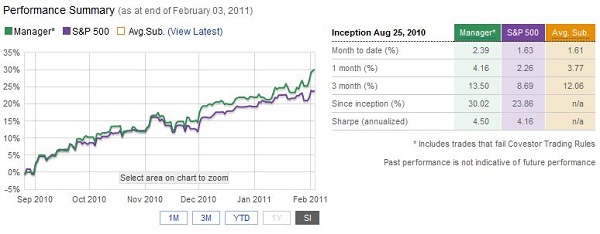Authors: Robert Preston & Clark Gates, Craigmillar Equity
Covestor model: Global Clean Energy-Clean Tech

The Craigmillar Energy Model has maintained healthy allocations to the major sectors: Industrials, Energy and Materials. These sectors were in the top half of the performance of the S&P 500 for 2010. The reason we did better than other alternative energy managers with these sectors is due to the broad nature of decarbonization as compared to alternative energy.
Alternative energy as defined by solar and wind is too narrow. For example, in the U.S., these energy sources make up only a small percentage of total energy produced, whereas the total U.S. energy industry provides $1 trillion in annual taxes and nearly 10 million in U.S. jobs. The areas that will change, due to the evolution of decarbonization, will be broader in technology, industrial process, materials, consumption, utilities and finance. This change will be long-term. Infrastructure, like homes and commercial buildings, will slowly adapt to the changes in energy technology. No doubt the last few years of economic contraction has hampered energy technology. This contraction has put solar at the bottom of the heap. Solar may have its day, but natural gas is at the front of the line for now.
Another change in energy technology has been on the demand side. Our portfolio is looking at opportunities such as LEDs, battery storage and the smart grid. In general, the demand side is less interesting because a change in demand requires buyer awareness. The buyer has to select a different choice of energy or service. The process of selecting companies that are likely to get this attention is difficult. The equation of success requires an understanding of human nature. Nevertheless, the demand side does have a meaningful upside in that the utility structure in the U.S. has been slow to change to new technologies. It is possible that the demand side could garner attractive margins because of the slow grinding improvement of the grid. This demand-side improvement also reflects the short-term nature of politics. Politics change often and this is not a sure way to invest long-term. We do have some investments in the demand side, but I prefer to stay with the supply-side that has given us a 150 year window of decarbonization. This is a trend we can bet on.
Throughout the year, we will continue to move more aggressively towards companies that will benefit from a faster adoption of new technologies. We expect 2011 will begin to reward new energy technology.
For example, recent reports from China, published by BBC News in Beijing (https://www.bbc.co.uk/news/world-asia-pacific-12107126), say that China has developed technologies to reprocess spent nuclear fuel. Evidently China has been working for 24 years to perfect a procedure to recycle material that can be reused in fueling nuclear power stations. China state TV claims this has significantly increased their overall supply of uranium for nuclear power – from 70 years to 3000 years. Few details are available on this reprocessing technology, but we have discussed the potential of thorium fuel as providing more energy at a lower price without waste and without the risk of producing nuclear weapons. We are not changing our portfolio today because of this development, but I doubt many investment funds are aware of these possibilities.
Energy evolution has been the catalyst for economic growth and these changes are what we use in making long-term stock decisions in the Craigmillar Energy Model. Energy technology will drive all of the sectors of our global economy. Our focus is with energy technology trends.


